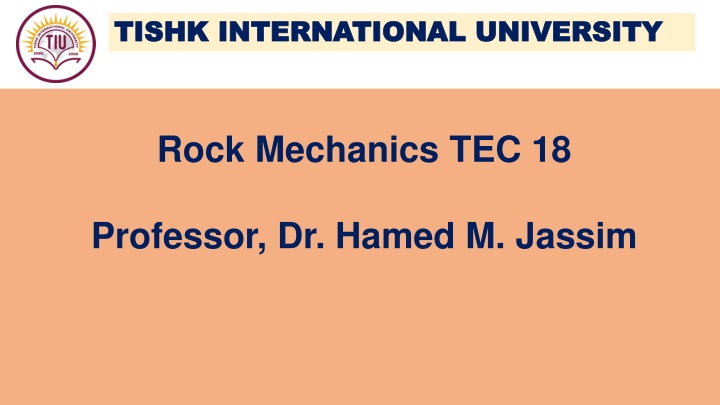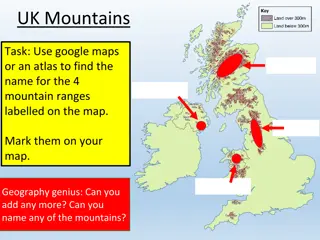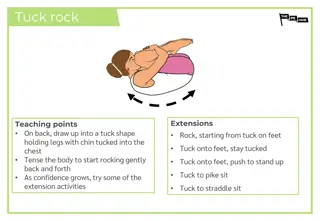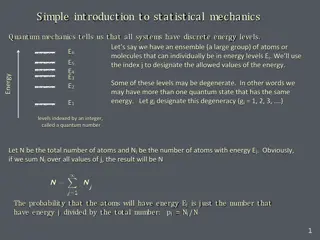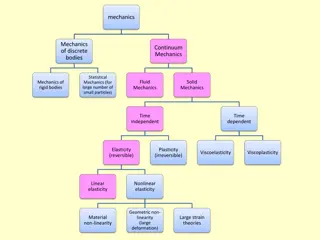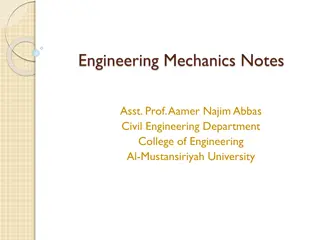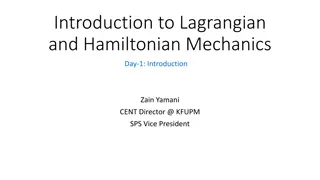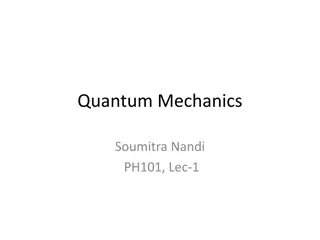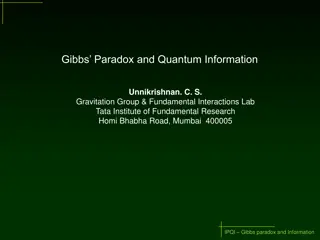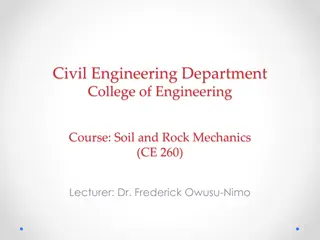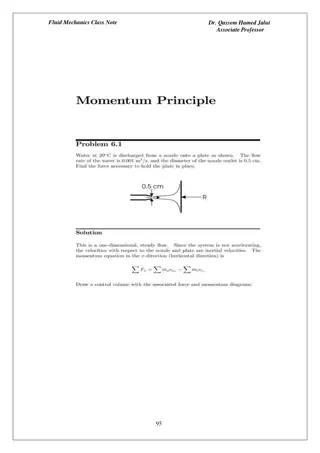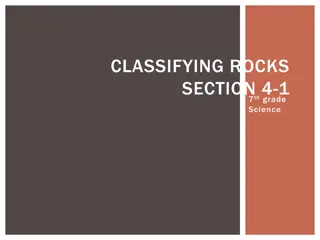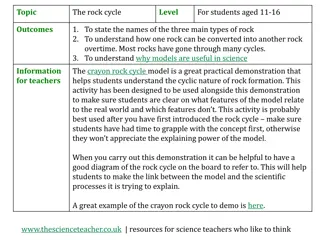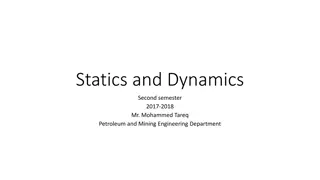Rock Mechanics TEC 18 Professor, Dr. Hamed M. Jassim
The Rock Mechanics course at TISHK INTERNATIONAL UNIVERSITY covers various topics such as Rock Mass Strength, RMR combined parameters, Stand Up Time for Tunnels, Rock Mass Deformability Modulus, and more. The course material includes input and output charts for determining different parameters related to rock mechanics, along with the Q-system for rock mass classification developed by Barton, Lien, and Lunde. Understanding concepts like RQD, joint roughness, joint water parameter, and stress reduction factor is essential for designing and supporting underground excavations.
Download Presentation

Please find below an Image/Link to download the presentation.
The content on the website is provided AS IS for your information and personal use only. It may not be sold, licensed, or shared on other websites without obtaining consent from the author.If you encounter any issues during the download, it is possible that the publisher has removed the file from their server.
You are allowed to download the files provided on this website for personal or commercial use, subject to the condition that they are used lawfully. All files are the property of their respective owners.
The content on the website is provided AS IS for your information and personal use only. It may not be sold, licensed, or shared on other websites without obtaining consent from the author.
E N D
Presentation Transcript
TISHK INTERNATIONAL UNIVERSITY TISHK INTERNATIONAL UNIVERSITY Rock Mechanics TEC 18 Professor, Dr. Hamed M. Jassim
TISHK INTERNATIONAL UNIVERSITY TISHK INTERNATIONAL UNIVERSITY Week 5 Rock Mass Strength - 2
TISHK INTERNATIONAL UNIVERSITY TISHK INTERNATIONAL UNIVERSITY Input Chart for determining RMR combined parameters RQD and discontinuity spacing
TISHK INTERNATIONAL UNIVERSITY TISHK INTERNATIONAL UNIVERSITY Output Chart for determining Stand Up Time for Tunnels as a function of RMR as a function of RMR
TISHK INTERNATIONAL UNIVERSITY TISHK INTERNATIONAL UNIVERSITY Output Chart for determining rock mass deformability modulus Em as a function of RMR
TISHK INTERNATIONAL UNIVERSITY TISHK INTERNATIONAL UNIVERSITY Output Chart for determining rock mass strength as a function of RMR
TISHK INTERNATIONAL UNIVERSITY TISHK INTERNATIONAL UNIVERSITY Output Chart for estimating tunnel support as a function of tunnel span and RMR rating
TISHK INTERNATIONAL UNIVERSITY TISHK INTERNATIONAL UNIVERSITY 2) The Q-system for rock mass classification is developed by Barton, Lien, and Lunde. It expresses the quality of the rock mass in the so-called Q-value, on which are based design and support recommendations for underground excavations. The Q-value is determined with
TISHK INTERNATIONAL UNIVERSITY TISHK INTERNATIONAL UNIVERSITY The first term RQD (Rock Quality Designation) divided by Jn (joint set number) is related to the size of the intact rock blocks in the rock mass. The second term Jr (joint roughness number) divided by Ja (joint alteration number) is related to the shear strength along the discontinuity planes and the third term Jw (joint water parameter) divided by SRF (stress reduction factor) is related to the stress environment on the intact rock blocks and discontinuities around the underground excavation.
TISHK INTERNATIONAL UNIVERSITY TISHK INTERNATIONAL UNIVERSITY A multiplication of the three terms results in the Q parameter, which can range between 0.001 for an exceptionally poor to 1000 for an exceptionally good rock mass. The numerical values of the class boundaries for the different rock mass qualities are subdivisions of the Q range on a logarithmic scale. The Q-value determines the quality of the rock mass, but the support of an underground excavation is based not only on the Q-value but is also determined by different terms in the above equation. This leads to a very extensive list of classes for support recommendations.
TISHK INTERNATIONAL UNIVERSITY TISHK INTERNATIONAL UNIVERSITY 3) Mining Rock Mass Rating (MRMR) system by modifying the Rock Mass Rating (RMR) system of Bieniawski. In the MRMR system the stability and support are determined with the following equations:
TISHK INTERNATIONAL UNIVERSITY TISHK INTERNATIONAL UNIVERSITY RMR = IRS + RQD + spacing + condition in which: RMR = Laubschers Rock Mass Rating, IRS = Intact Rock Strength RQD = Rock Quality Designation, spacing = expression for the spacing of discontinuities condition = condition of discontinuities (parameter also dependent on groundwater presence, pressure, or quantity of groundwater inflow in the underground excavation) MRMR = RMR * adjustment factors,in which: adjustment factors = factors to compensate for: the method of excavation, orientation of discontinuities and excavation, induced stresses, and future weathering
TISHK INTERNATIONAL UNIVERSITY TISHK INTERNATIONAL UNIVERSITY Systems for slope engineering 1) Slope Mass Rating (SMR) and Continuous Slope Mass Rating 2) Q-slope 3) Rock mass classification system for rock slopes 4) Slope Stability Probability Classification (SSPC)
TISHK INTERNATIONAL UNIVERSITY TISHK INTERNATIONAL UNIVERSITY 1) Slope Mass Rating or SMR is a rock mass classification scheme developed by Manuel Romana to describe the strength of an individual rock outcrop or slope. The system is founded upon the more widely used RMR scheme, which is modified with quantitative guidelines to rate the influence of adverse joint orientations (e.g. joints dipping steeply out of the slope).
TISHK INTERNATIONAL UNIVERSITY TISHK INTERNATIONAL UNIVERSITY 2) Q-slope method for rock slope engineering and rock mass classification is developed by Barton and Bar. It expresses the quality of the rock mass for slope stability using the Q-slope value, from which long- term stable, reinforcement-free slope angles can be derived. The Q-slope value can be determined with:
TISHK INTERNATIONAL UNIVERSITY TISHK INTERNATIONAL UNIVERSITY Q-slope utilizes similar parameters to the Q-system which has been used for over 40 years in the design of ground support for tunnels and underground excavations. The first four parameters, RQD (rock quality designation), Jn (joint set number), Jr (joint roughness number) and Ja (joint alteration number) are the same as in the Q-system.
TISHK INTERNATIONAL UNIVERSITY TISHK INTERNATIONAL UNIVERSITY However, the frictional resistance pair Jr and Ja can apply, when needed, to individual sides of a potentially unstable wedges. Simply applied orientation factors (0), like (Jr/Ja)1 x 0.7 for set J1 and (Jr/Ja)2 x 0.9 for set J2, provide estimates of overall whole-wedge frictional resistance reduction, if appropriate. The Q-system term Jw is replaced with Jwice, and takes into account a wider range of environmental conditions appropriate to rock slopes, which are exposed to the environment indefinitely.
TISHK INTERNATIONAL UNIVERSITY TISHK INTERNATIONAL UNIVERSITY The conditions include the extremes of erosive intense rainfall, ice wedging, as may seasonally occur at opposite ends of the rock-type and regional spectrum. There are also slope-relevant SRF (Strength Reduction Factor) categories. Multiplication of these terms results in the Q-slope value, which can range between 0.001 (exceptionally poor) to 1000 (exceptionally good) for different rock masses.
TISHK INTERNATIONAL UNIVERSITY TISHK INTERNATIONAL UNIVERSITY A rock mass is classified following a standardized set of criteria in one or more exposures ( exposure classification). These values are converted per exposure to a reference rock mass by compensating for the degree of weathering in the exposure and the method of excavation that was used to make the exposure, i.e. the reference rock mass values are not influenced by local influences such as weathering and method of excavation.
TISHK INTERNATIONAL UNIVERSITY TISHK INTERNATIONAL UNIVERSITY A new slope can then be designed in the reference rock mass with compensation for the damage due to the method of excavation to be used for making the new slope and compensation for deterioration of the rock mass due to future weathering (the slope rock mass). If the stability of an already existing slope is assessed the exposure and slope rock mass values are the same.
TISHK INTERNATIONAL UNIVERSITY TISHK INTERNATIONAL UNIVERSITY Correlation between UCS and PLS Qu = 16.3 + 15.3 Is (50) Where Qu = Uniaxial Compressive Strength of rock. Is(50) = Point Load Index for 50 mm diameter core.
TISHK INTERNATIONAL UNIVERSITY TISHK INTERNATIONAL UNIVERSITY
TISHK INTERNATIONAL UNIVERSITY TISHK INTERNATIONAL UNIVERSITY For size correction UCS = 24 X Is(50) Bieniawski suggested the following approximate relation between UCS, Is and the core diameter (D). UCS = (14 + 0.175 D) X Is(50)
TISHK INTERNATIONAL UNIVERSITY TISHK INTERNATIONAL UNIVERSITY Correlation between UCS and Schmidt Hammer N Value where UCS is in MPa, and N = Schmidt Hammer Value (Strength)
